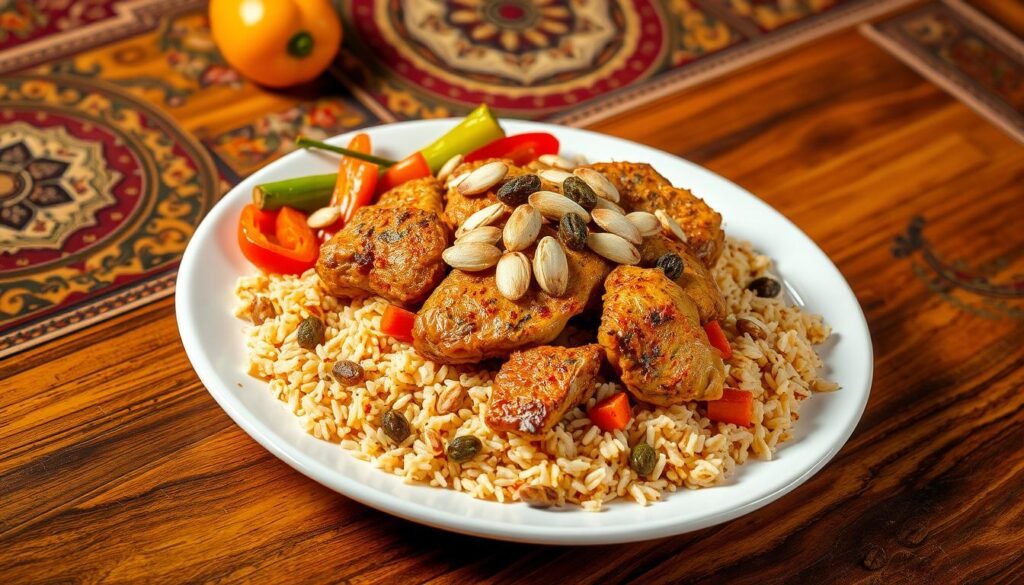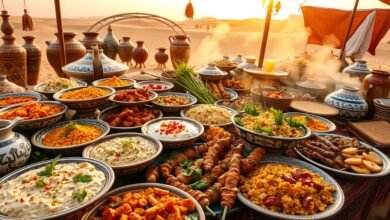Traditional Saudi Foods: From Dates to Kabsa & More

Ever wondered about the tasty treats in the Arabian Peninsula? Saudi Arabia’s food is a rich journey that goes beyond falafel and hummus. It includes everything from sweet dates to the famous kabsa. What makes these dishes so special and loved worldwide?
We’re going to explore Saudi’s food scene together. We’ll look at its history, different flavors, and key ingredients like dates. These have made Saudi food a true delight for everyone.
Understanding the Rich Heritage of Saudi Arabian Cuisine
The food of Saudi Arabia is a mix of history, culture, and different regions. Exploring Saudi cuisine shows us how these elements have shaped its unique flavors.
Historical Influences on Saudi Food Culture
Saudi Arabian food has been shaped by its location at the crossroads of ancient trade routes. The exchange of spices and cooking methods from the Middle East, Africa, and Asia has deeply influenced its cuisine. Islamic traditions and rituals have also played a big role in shaping Saudi food culture.
Regional Variations Across the Kingdom
Despite its shared culture, Saudi Arabia’s diverse geography has led to different food styles in each region. Coastal areas focus on seafood, while the interior is known for meat dishes. This shows the adaptability and richness of Saudi Arabian cuisine.
The Role of Bedouin Traditions
The Bedouin nomadic lifestyle has greatly influenced Saudi Arabian cuisine. Their connection to the land, use of seasonal produce, and traditional cooking methods have created unique flavors and techniques. These traditions are a big part of Saudi cuisine.
| Historical Influences | Regional Variations | Bedouin Traditions |
|---|---|---|
| Trade Routes | Coastal Seafood Dishes | Seasonal Produce |
| Islamic Traditions | Interior Meat Specialties | Traditional Cooking Methods |
| Ingredient Exchange | Adaptability of Cuisine | Connection to the Land |
From Dates to Kabsa: Traditional Saudi Foods You Must Try
Exploring saudi arabian cuisine is a journey into the heart of the Kingdom. It reveals the traditions and flavors of the land. From the sweet dates to the famous Kabsa, these authentic saudi recipes offer a unique taste experience.
Dates are a key part of saudi arabian cuisine. These sweet fruits are loved for their taste and use in many dishes. They are a big part of Saudi culture, enjoyed every day.
Kabsa is another highlight of Saudi food. It’s a rice dish with spices, herbs, and meats. It shows the mix of flavors that make middle eastern food special.
| Traditional Saudi Dishes | Key Ingredients | Cultural Significance |
|---|---|---|
| Dates | Sweet, plump dates | A sacred fruit deeply rooted in Saudi culture and cuisine |
| Kabsa | Rice, meat (chicken, lamb, or beef), spices, and herbs | The national dish of Saudi Arabia, showcasing the country’s culinary heritage |
There are many more authentic saudi recipes to discover. As you explore saudi arabian cuisine, you’ll find rich flavors and traditions in every dish.
The Significance of Dates in Saudi Culture and Cuisine
In the Arabian Peninsula, the date palm is a symbol of Saudi culture. It’s a key part of the country’s rich food history. From the green oases to the hot deserts, dates are deeply rooted in Saudi identity.
Popular Date Varieties in Saudi Arabia
Saudi Arabia has many date types, each with its own taste and cultural value. Medjool dates are loved for their soft, sweet texture. Sukkari dates are crunchy and sweet.
Barhee dates have a floral taste, and Khudri dates are known for their strong, earthy flavor. These dates are highly valued in the region.
Traditional Date-Based Desserts
- Sfouf: A fragrant, golden-hued semolina cake infused with dates, cardamom, and rose water.
- Qatayef: Crescent-shaped pancakes filled with sweetened date paste and topped with syrup and crushed nuts.
- Luqaimat: Fluffy, deep-fried dough balls dipped in a sweet date-infused syrup.
Modern Date Preparations
Saudi chefs are now using dates in new ways. They make date smoothies, date-infused ice creams, and even date-based condiments. This shows how versatile dates can be in both sweet and savory dishes.
Kabsa: The National Dish of Saudi Arabia
In Saudi Arabia, kabsa is the top dish in the kingdom’s traditional food. It’s a rice dish filled with spices and slow-cooked meats. It’s more than food; it brings Saudis together.
The story of kabsa starts with the Bedouin tribes of the Arabian Peninsula. They cooked meats and grains over hot coals. The dish uses basmati rice, lamb or chicken, and spices like cinnamon, cardamom, cloves, and black pepper.
Kabsa changes a bit in different parts of Saudi Arabia. In the Hijaz region, it has more tomatoes and herbs. The eastern provinces add saffron and dried limes for extra flavor.
| Region | Kabsa Variation |
|---|---|
| Hijaz | More tomatoes and herbs |
| Eastern Provinces | Saffron and dried limes |
Making kabsa takes a lot of time and effort. The rice cooks in a spice-infused broth. The meat is slow-cooked until it’s very tender. This creates a dish full of flavors.
Kabsa is more than food; it’s a big part of Saudi culture. It’s served at family events and celebrations. For Saudis, eating kabsa is a way to connect with their heritage.

Essential Spices and Aromatics in Saudi Cooking
Saudi Arabian cuisine is known for its rich flavors. It uses spices and aromatics that make dishes taste amazing. These elements show the cultural influences in Saudi cooking.
Common Spice Blends
Some spice blends are key in Saudi cooking. Baharat is a mix of spices like black pepper and cinnamon. It’s used in many dishes.
Duqqa is a nutty seasoning made with toasted nuts and spices. Za’atar, with thyme and sumac, is also very popular.
Traditional Seasoning Techniques
- Marinating meats and vegetables in spices and citrus is a traditional method.
- Slow-cooking helps spices blend together, creating great flavors.
- Using whole spices ensures the best taste and aroma.
Storage and Preparation Tips
| Spice | Storage | Preparation |
|---|---|---|
| Cardamom | Airtight container, away from light | Pods crushed or ground just before use |
| Cinnamon | Airtight container, in a cool, dark place | Sticks or ground, depending on the dish |
| Cumin | Airtight container, away from heat and moisture | Whole seeds or ground |
Learning about spices and seasoning can help you make authentic Saudi dishes. It lets you explore the rich traditions of saudi arabian cuisine and regional arabic culinary traditions.
Traditional Saudi Breakfast Dishes
Saudi Arabian cuisine is rich in tradition, especially at breakfast. Dates and kabsa are key to Saudi meals. The breakfast table shows the heart of Saudi culinary customs.
Mudabbas: The Quintessential Saudi Breakfast
Mudabbas is a beloved dish in Saudi Arabia. It’s simple yet elegant. It includes fresh dates, Arabic coffee, or tea.
Dates are sweet and nutritious. They show Saudi’s deep connection to the date palm tree. This tree is a symbol of Saudi culture.
Ful Medames: A Hearty and Flavorful Start
Ful medames is a savory fava bean dish. It’s slow-cooked with spices, garlic, and lemon. This makes it robust and satisfying.
It’s often served with warm flatbread, chopped onions, and cumin. This adds to its flavor.
| Traditional Saudi Breakfast Dishes | Key Ingredients | Preparation |
|---|---|---|
| Mudabbas | Dates, Arabic coffee, tea | Dates are served fresh, with coffee or tea as accompaniments. |
| Ful Medames | Fava beans, spices, garlic, lemon | Fava beans are slow-cooked and seasoned with a blend of spices, garlic, and lemon. Served with flatbread, onions, and cumin. |
| Shakshuka | Eggs, tomatoes, onions, peppers, spices | Eggs are poached in a flavorful sauce of tomatoes, onions, peppers, and aromatic spices. |

These dishes show the diversity and richness of Saudi cuisine. Enjoying Mudabbas or Ful Medames is a great way to start the day. They offer a taste of Saudi culture and Middle Eastern food.
Popular Saudi Meat Dishes and Preparations
The Arabian Peninsula is famous for its rich food culture, and Saudi Arabia is no different. Its food is shaped by many cultures, showing off the unique tastes and ways of making saudi recipes. Meat dishes are a big part of Saudi food, showing the country’s deep connection to its regional arabic culinary traditions.
Lamb and Mutton Specialties
Lamb and mutton are very special in Saudi food, with many different ways to make them. You might enjoy muttareh, a slow-cooked lamb stew, or saleeg, a rice dish with tender lamb. These dishes show the heart of arabian peninsula gastronomy. The skill in grilling and roasting makes these meats even more delicious.
Camel Meat Delicacies
Camel meat is common in many Bedouin diets and is also in Saudi food. You can try magbous, a rice dish with slow-cooked camel meat, or madbi, grilled camel meat. These dishes show how camel meat is used in authentic saudi recipes that have been passed down for generations.
Grilling and Roasting Methods
Grilling and roasting meat is a big part of Saudi cooking. Traditional methods, like using wood-fired ovens and special skewers, give meat a smoky taste and tender texture. This skill, learned over centuries, shows the lasting regional arabic culinary traditions that make up arabian peninsula gastronomy.
| Dish | Description | Key Ingredients |
|---|---|---|
| Muttareh | A slow-cooked lamb stew with aromatic spices | Lamb, onions, tomatoes, spices (cinnamon, cardamom, cloves) |
| Saleeg | A rice dish featuring tender, slow-cooked lamb | Lamb, rice, onions, tomatoes, spices (cinnamon, cardamom, saffron) |
| Magbous | A rice-based preparation with slow-cooked camel meat | Camel meat, rice, onions, tomatoes, spices (cardamom, cloves, saffron) |
| Madbi | A grilled camel meat dish | Camel meat, salt, black pepper |
Saudi Desserts and Sweet Delicacies
Saudi Arabian cuisine is known for its rich flavors and diverse desserts. It includes traditional date treats and modern Middle Eastern sweets. The variety is a feast for the senses.
Indulging in Date-Inspired Delights
Dates are a key ingredient in Saudi desserts. They are sweet and nutritious. Mutabak is a flaky pastry with a sweet date paste inside.
Layali Lubnan is a creamy dessert with date syrup and nuts. It’s a favorite in Saudi Arabia.
Savoring Fragrant Semolina Sweets
Semolina is a coarse wheat flour used in Saudi desserts. Basbousa is a moist cake soaked in rose water syrup. It’s a beloved treat.
Qatayef are pancakes filled with sweet cheese or nuts. They’re drizzled with syrup for extra flavor.
Exploring Modern Interpretations
Modern chefs and home cooks have added their twist to traditional desserts. Umm Ali is a creamy pudding with puff pastry and nuts. It’s a modern take on a classic.
Baklava is a flaky pastry with honey and nuts. It’s a popular choice in Saudi Arabia, showing the diversity of desserts.
The world of saudi arabian cuisine and middle eastern food is full of date fruits recipes and sweet treats. From traditional to modern, there’s something for everyone to enjoy.
Traditional Cooking Methods and Utensils
Saudi cuisine is deeply rooted in the region’s cultural traditions. It showcases the ingenuity and resourcefulness of the Saudi people. From ancient cooking techniques to essential kitchen tools, the culinary practices of the Arabian Peninsula are remarkable.
Ancient Cooking Techniques
Traditional Saudi cooking uses time-honored techniques passed down through generations. These methods often use natural elements, showing the region’s adaptability. Some examples include:
- Shuwa: A slow-cooking method where meat is wrapped in palm leaves or cloth and buried in a pit filled with hot coals to create tender, flavorful dishes.
- Madgag: The art of cooking meat, vegetables, and grains over an open fire, often using a specialized grill or brazier.
- Tannour: The traditional bread-baking technique that involves cooking flatbreads in a domed clay oven, imparting a unique texture and taste.
Essential Kitchen Tools
The authentic Saudi kitchen has specialized tools for preparing iconic dishes. These tools reflect the region’s rich culinary heritage and the ingenuity of its people:
| Tool | Purpose |
|---|---|
| Mortar and Pestle | Used for grinding and pounding spices, herbs, and other ingredients to create flavorful pastes and mixtures. |
| Mabkhara | A traditional incense burner used to perfume the air and enhance the dining experience. |
| Majmar | A metal plate or griddle used for cooking flatbreads, such as the beloved Khubz. |
These traditional cooking methods and essential kitchen tools show the ingenuity of the Saudi people. They have perfected the art of saudi culture through cuisine and authentic saudi recipes over centuries. This is within the arabian peninsula gastronomy.
The Art of Saudi Coffee and Tea Rituals
In Saudi culture, coffee and tea rituals are very important. They are not just drinks, but key parts of Saudi society. Exploring these traditions shows us a world where friendship, connection, and heritage come together.
Making Saudi coffee, or “qahwa,” is a special tradition. The smell of roasted and cardamom-flavored beans signals the start of a ritual. The way the coffee is poured, with its unique rhythm and thick foam, is truly captivating.
Tea-making in Saudi Arabia is also highly valued. From mint tea to black tea, each cup tells a story of Arabic culinary traditions. The careful brewing shows how these drinks bring people together and share culture.
FAQ
What are the most popular traditional Saudi foods?
In Saudi Arabia, kabsa (a rice and meat dish) is the national dish. Dates are also very important, both culturally and in cooking. Other favorites include lamb and camel meat, traditional breakfasts, and sweet desserts.
How has Saudi Arabian cuisine been influenced by the region’s history and culture?
Saudi cuisine reflects the country’s rich history and culture. Trade routes, Islamic traditions, and Bedouin customs have all played a role. The Kingdom’s different regions add to the variety in flavors and cooking styles.
What is the significance of dates in Saudi culture and cuisine?
Dates are very important in Saudi Arabia. They are grown locally and used in desserts and other dishes. This fruit is a big part of Saudi identity and food culture.
What are the essential spices and aromatics used in Saudi cooking?
Saudi cooking relies on spices like saffron, cinnamon, and cumin. These spices are used in special ways to create the unique flavors of Saudi dishes.
What are some popular Saudi breakfast dishes?
Saudi breakfasts often include breads, eggs, and creamy porridges. They also have honey, cheese, and olives. These dishes show the importance of breakfast in Saudi culture.
How are meat dishes prepared in Saudi cuisine?
Saudi cuisine features grilled, roasted, and slow-cooked meats. Lamb, mutton, and camel are favorites. These methods make the meat tender and flavorful.
What are some of the unique Saudi desserts and sweet delicacies?
Saudi sweets are diverse, with date-based and honey-sweetened treats. There are also milk-based puddings and custards. These desserts highlight the creativity and love for sweets in Saudi culture.
What are some of the traditional cooking methods and utensils used in Saudi cuisine?
Saudi cooking uses ancient methods like clay ovens and wood-fired grilling. Important tools include pots, pans, and serving dishes passed down through generations.
How are coffee and tea rituals celebrated in Saudi culture?
Coffee and tea are big in Saudi culture. They are part of hospitality and served with special rituals. These drinks are important in social gatherings.




